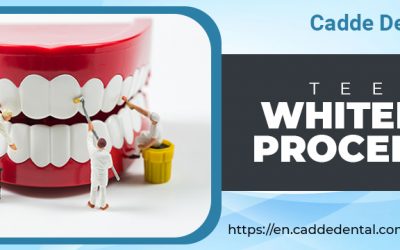In-Depth Study on Dental Bonding Treatment

What happens if you lose your teeth while still alive? When it comes to your look, your teeth are the most noticeable feature. Isn’t that so? Nobody wants their teeth to be crooked, chipped, or cracked. However, we now have fantastic treatment alternatives such as Cosmetic Dental Bonding due to advancements in technology. Let’s start with a definition of Dental Bonding.
What Is Teeth Bonding?
Dental bonding is a procedure that allows your dentist to use dental resin to repair aesthetic issues. Teeth discolored, chipped, fractured, deformed, or separated by unsightly small gaps might benefit from dental bonding. They’re composed of a unique resin that may be tinted to match or complement the color of your natural teeth. Your dental bond is molded after it has been applied to give it a natural appearance. Unlike veneers and crowns, dental bonding is a fast process that does no damage to the original tooth structure.

A cosmetic dentistry surgery like tooth bonding can give you the confidence to show off your pearly whites if you have a chipped, broken, or discolored tooth. Tooth bonding is a treatment in which your dentist uses a tooth-colored composite bonding turkey to repair damage to one or more of your teeth. It’s a cost-effective option because it’s far less expensive than crowns and veneers, for example.
Benefits of Tooth Bonding
However, before having any dental treatment or surgery, we usually attempt to learn about the benefits and drawbacks. We attempt to comprehend its precautions and aftercare. We only give the green light for the next step when we have all of this information. The same may be said for aesthetic dental bonding. On the other hand, Dental Bonding is a dental procedure that has several advantages over veneers or crowns. Dental Bonding is an excellent option for people who have small defects in their teeth.
Cost-effective
One of the simplest and least costly cosmetic dental treatments is bonding. In most cases, your dental bond may be completed in only one office visit. Other cosmetic dental procedures, such as crowns and veneers, may need many sessions. Dental bonding is also a wonderful way to hide unattractive gaps without going through the time and expense of orthodontics. Anesthesia is typically not necessary unless dental bonding is being utilized to fill a cavity.
Fortunately, dental Bonding is less expensive than dental veneers or crowns, similar to teeth whitening. Furthermore, many dental insurance policies cover the majority of the cost of dental care.
Requires Less Time
When compared to veneers or crowns, dental bonding takes less time to complete. The entire dental bonding procedure may be completed in only one session. So, if you’re short on time, dental bonding could be the best option for you. Furthermore, Cosmetic Dental Bonding does not necessitate the use of a dental laboratory and may be done right in the office. Without orthodontics, the technique, which includes putting material to each of the teeth to be treated or aligning the teeth, can be completed.
Safe & Secure
Silver fillings used to have a chemical leak over a while, causing harm to the body. However, unlike silver fillings, the substance and composite utilized in dental bonding are entirely biocompatible and pure. This implies it doesn’t include any potentially hazardous chemicals or compounds. Furthermore, cosmetic dental Bonding uses a substance that binds directly to the teeth and forms a flawless seal, keeping the region germ-free and protecting teeth from infection at the filling site.
Enamel Remains Safe
Dental Bonding, unlike porcelain veneers, does not harm your enamel. Additionally, no preparation work is necessary before the application of dental bonding. The dentists will merely clean your teeth before applying the composite resin to give them the shape they want. There is no need for the patient to be concerned about their teeth being harmed. In addition, the patient does not need to make repairs for the rest of their life. When the veneers become worn, you must replace them to cover the damaged enamel. Dental Bonding, on the other hand, does not require replacement.
Aesthetic Benefits
For minor tooth defects, cosmetic dental bonding is the most popular treatment method. You have the option of selecting a composite resin that is the same color as your teeth. The dental Bonding will be so similar to the enamel that even someone standing next to you will not detect the bonded teeth. The bonding substance may brighten your smile, fill in gaps between your teeth, and make your teeth appear more aligned and flawless. Dental bonding also improves the appearance of your teeth. These are some of the reasons why dental bonding is so popular. Check composite bonding before after looks to see the difference.

How Does It Work?
Dental bonding is applied directly to your natural tooth enamel. To guarantee that the bonding material clings to the tooth, your dentist will etch the enamel with roughing gel and then cover the teeth with a conditioning treatment. You and your dentist will choose a resin color that best fits your smile. The composite material is then sculpted into shape and put to the tooth. Your dentist will polish and buff the bond to give it a natural sheen once it has dried and set using a special ultraviolet light.
What Should I Know About the Dental Bonding Process?
- Before the Bonding Process: Dental bonding does not need a great deal of forethought. Furthermore, unless bonding is utilised to fill a decaying tooth, anaesthetic is rarely required.
- The Bonding Process: Your dentist will choose a composite resin (a durable plastic substance) that closely matches the colour of your tooth using a shade guide. A conditioning liquid is administered to the tooth’s surface after it has been roughened. These processes aid the bonding material’s adhesion to the tooth. The tooth is then covered in a tooth-coloured, putty-like resin applied, shaped, and smoothed to the appropriate form. The resin is then cured using a specific light that “bonds” the substance to the tooth’s surface. Finally, your dentist will shape, polish, and trim the bonded material to match the rest of the tooth/shine. teeth’s
- How Long it Takes to Complete: Each tooth takes 30 to 60 minutes to finish the process.
Dental Bonding- Aftercare Practices
Although Cosmetic Dental Bonding does not need any particular attention, you should keep these basic things in mind to ensure that your bonded teeth remain healthy and long-lasting.
- Oral hygiene is an important habit to follow. Brush your teeth at least twice each day. Brushing your teeth after a meal is the finest time.
- Every day, floss and clean your mouth with mouthwash.
- Fluoridated toothpaste should always be used since it helps to strengthen tooth enamel and decreases the risk of decay.
- Soft drinks, fruit juices, cordial, coffee, tea, and other acidic beverages should be avoided. Acids soften the substance of the teeth, causing holes or cavities.
- Sugar-based diets should be avoided since they cause tooth decay.
- Avoid doing things that aren’t required with your teeth, such as removing bottle tops or cracking nuts. It has the potential to cause long-term harm to the teeth.
- To avoid tooth decay and discolouration, stop smoking.
- Visit your dentist for basic checkups regularly.
- These are the benefits of dental bonding, as well as some aftercare suggestions. Dental Bonding is the definitive therapy for small dental defects and abnormalities, as you may have realised.
Disadvantages
Although the substance used in dental bonding is stain-resistant, it does not outperform crowns regarding stain resistance. Another downside of bonding materials is that they do not last as long or other types of tooth restoration, like crowns, veneers, or fillings. Bonding materials can sometimes chip and break away from the tooth. Some dentists believe that bonding is ideal for making minor, aesthetic modifications, repairing teeth in regions with extremely little biting pressure, and creating a temporary remedy for cosmetic flaws.

Conclusion
It is critical to examine the dentist’s training and experience when selecting a cosmetic dentist. This guarantees that the dentist you pick uses cutting-edge cosmetic dentistry techniques and materials. For these reasons, dental bonding is the ideal method for repairing damaged, chipped, decaying, or gapped teeth. Composite material is not only safe and functional, but it is also naturally attractive! Cadde Dental employs cutting-edge technology to deliver painless, incision-free treatment and smile aesthetics in turkey.
Recent Posts
- Learn Everything About The Treatment Procedure of Laminated Teeth
- Signs You Should Notice and Get Your Implants Done – Full Dental Implants Turkey
- All About Dental Braces and What Should You Know Before Getting
- Learn About The Importance and Process of Interdental Cleaning
- How Sugar Can Harm Your Oral Health and How To Deal With It?
Categories
- Aesthetic Zirconium Coating
- Best Dental Clinic in Turkey
- Blog
- Dental Bonding Treatment
- dental implant in Turkey
- Dental Treatment in Turkey
- Full Mouth Dental Implants Cost Turkey
- Full mouth Veneers Cost in Turkey
- General
- Hollywood smile in Antalya
- Hollywood Smile Price in Turkey
- Hollywood smile prices
- Hollywood Smile Treatment
- Izmir Implant Treatment
- Laminated Teeth Application
- Laminated Tooth London
- smile aesthetic London
- Smile Aesthetics in Turkey
- Smile Makeover Turkey
- teeth whitening procedure
- Teeth Whitening Treatment in Turkey
- Teeth Whitening Treatment in Turkey
- Turkey Implant Prices
- Wisdom Tooth Extraction Procedure
- Zirconia Dental Implants
- Zirconium Crowns Turkey
- Zirconium Teeth London



Recent Comments